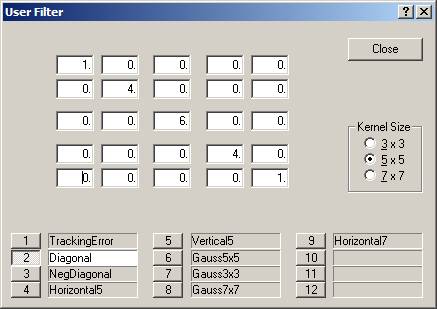

Download "User Defined Kernel" Richardson-Lucy script for MaximDL.
Download "Gaussian Kernel" Richardson-Lucy script for MaximDL.
To install: right click above links and select "Save As". Then save these files anywhere you like on your computer. It is convenient to put them in a folder that is easy to navigate to from your image folders. Then, in MaximDL, click File->RunScript and select the script you want from the file selection window.
NOTE: I've recently developed a new script that seems better than the "Gaussian Kernel" script described on this page. Click here for the new script.
 |
 |
For details read on...
Here's a stack of several calibrated images of M16 (the Eagle nebula):

The image appears soft because it is slightly out of focus and there was some tracking and/or polar alignment error.
Let's first correct for the tracking/alignment error using the "User Defined
Kernel" version of the script. The first step is to define the appropriate
kernel. Click
Kernel->KernelFilter->UserFilter->Set.
Since the image here seems to have a roughly diagonal elongation,
I set up a kernel filter along the diagonal:

How many iterations? 2
Which convolution filter? 2
Standard Deviation of Background? 100
To find the standard deviation of the background, I used MaximDL's Information window in "aperture" mode and moved the cursor over a part of the background. Anyway, here's the result:

Not perfect, but better.
Next, let's correct for the blurring due to defocus/seeing using the "Gaussian
Kernel" version of the script.
Again using MaximDL's Information window in "aperture" mode, move the cursor
over a few stars and take note of the FWHM. Make sure the readout is in
pixels, not arcseconds. Then, fire up the vbs script:
File->RunScript->RLdeconvGaussianPSF.vbs
Again you are prompted to answer three questions.
Here are the questions and the answers I gave for this example:
How many iterations? 5
FWHM (in pixels)? 2.5
Standard Deviation of Background? 100
Here's the result:

I think you'll agree that the final result is much improved.